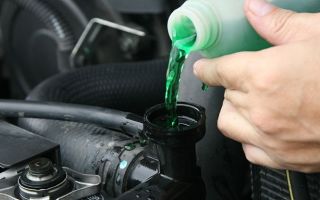Replacing coolant: 3 main stages, secret nuances from a professional
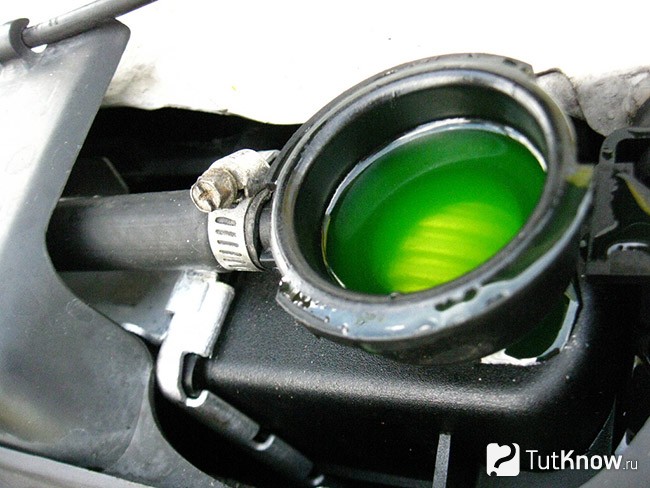

The cooling system can be filled with:
- antifreeze;
- distilled water;
- or antifreeze made from glycol.
The working volume of coolant depends on the design of the cylinder block, the installed radiator and the pipeline. Replacing coolant is an important procedure that is performed in conjunction with flushing the cooling system.
Why is it necessary to change the coolant?
Antifreeze differs from distilled water in its boiling point and the rate at which heat is removed from the walls of the block. The liquid in the cooling system is periodically changed, since it is designed for a certain resource, after which the anti-corrosion and functional properties of the coolant are lost.
Check the coolant level in the expansion tank. The liquid gradually boils away and needs to be replenished periodically.
Replacement is also carried out when the cooling system is contaminated. The radiator and pipes gradually become clogged, which can lead to a blockage. The engine may overheat and seize due to a clogged cooling system:
- corrosive particles and dust;
- salt deposits on the internal channels of the radiator and block;
- blockage of pipes with oxidative sediment.
The expansion tank of the engine cooling system is used to control the coolant level. When adding fluid in a timely manner, pay attention to the visual condition of the antifreeze. Signs for replacement: change in color, consistency, appearance of cloudy sediment and solid particles.
When should you change the coolant?
Replacement is carried out after passing a certain mileage - 40-50 thousand km. When undergoing maintenance, they check the coolant level in the tank and conduct a visual inspection for impurities.
Cloudiness and a change in shade indicate foreign inclusions in the coolant or a change in the properties of the composition.
The need to clean the cooling system and replace the coolant is indicated by a number of signs that are reflected in changes in the operation of the car:
- frequent overheating and boiling of the coolant;
- constant operation of the internal combustion engine at a critical temperature (the water sensor shows maximum readings);
- interruptions when starting a warm engine;
- change in rheostat response and problems with pump operation.
If such situations arise or the color of the coolant changes to a reddish color, the cooling system must be immediately cleaned and the coolant replaced.
Coolant replacement
After traveling a certain mileage or identifying problems in the cooling system, it is necessary to undergo vehicle maintenance. You can visit a service station or perform the process yourself. How to replace coolant?
Replacement is carried out on a cooled engine and using protective equipment.
To carry out the procedure you will need:
- set of tools - screwdrivers and wrenches,
- containers for draining waste,
- rubberized gloves,
- flushing additives,
- new coolant - distilled water, antifreeze or other antifreeze.
The car is placed on an inclined platform or overpass - in this position the liquid drains better from the system.
The procedure is carried out as follows:
- Install a container to drain the old coolant.
- Remove the radiator pipe.
- Unscrew the valve on the flow control tank. After the system is completely emptied, the remains are drained from the cylinder block.
- Having removed the dust shield, open the valve on the interior heater apparatus (to bleed the pipeline).
After draining all the used antifreeze, proceed to preparing the flushing composition.
Radiator flushing
To clean technological channels from oxidative sediment and rust, special chemical additives or folk cleaning products are used. You can remove salt deposits using citric acid, soda and even cola.
To prepare the compositions, carefully read the instructions. Additives are mixed in certain proportions, and the period and method of washing differs in the time of exposure of the reagent in the system.
Washing steps and sequence:
- prepare a solution,
- fill the system and close the drain holes,
- start and warm up the engine according to the mode specified in the additive instructions.
After working for some time (up to 30 minutes or driving 10 - 15 km), wait until the engine cools down.
Adding fresh antifreeze
Before filling in new coolant, the pipeline elements are checked for integrity (cracks and wear). Some rubber hoses, clamps and gaskets will need to be replaced.
Do not forget about the possibility of air pockets - fill with CO until the air is completely bled out.
Sequence of stages:
- The radiator is washed with water to remove old additives and remaining silt inclusions.
- Connect the car's heating system.
- Add a couple of liters of distilled water, and then gradually add antifreeze.
- Filling is carried out until liquid exits the technical channels.
After completing the work, before starting the engine, check the filling level of the system and tightly close the filler tank cap.
At the final stage, fix the pipes with clamps and start the engine. At increased speeds (about 3 minutes), complete circulation of antifreeze occurs in the system. Subsequent monitoring is carried out after the engine has cooled down, when the pressure in the system drops. If necessary, add antifreeze to the expansion tank to the average level.
Coolants on the market
There are several main types of coolant: standard, hybrid and carboxylate (G11, G12+). The main component used for production is ethylene glycol. To classify additives, marked symbols are used to indicate functional features. The most popular are anti-foam and anti-corrosion additives:
- Traditional antifreezes (Tosol) are made on the basis of silicates. The principle of operation is to cover the internal elements of the cooling system with a protective film, which thickens as the mileage passes. When the engine overheats (more than 105 °C), the film is destroyed and precipitates in flakes.
- Hybrid versions are made from carboxylic acid. Service life without replacement is up to 2 years. Their peculiarity is the formation of a protective film only in areas with elements of corrosion.
Conclusion
Regular monitoring of coolant quality and checking its level in the tank are important conditions when operating a car. Timely replacement of the coolant will prevent the engine from overheating and protect the internal surfaces of the internal combustion engine from corrosion.
Article rating:
(3
Source: https://motorsguide.ru/advice/kak-samostoyatelno-zamenit-ohlazhdayushhuyu-zhidkost
Replacing coolant in a car
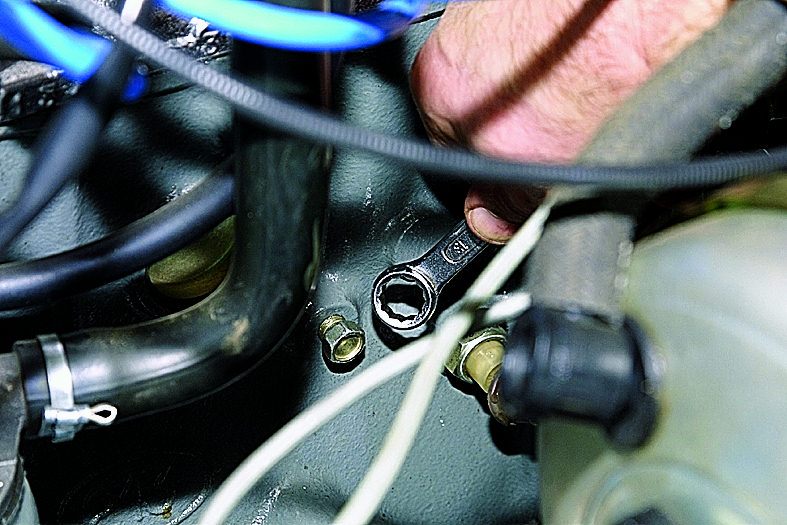
Many inexperienced motorists often wonder: how to distinguish antifreeze from antifreeze and what to fill with the cooling system? When literally translated into Russian, the word “antifreeze” means nothing more than “anti-frost.”
In fact, antifreeze can be called any coolant that can not freeze at fairly low temperatures.
Antifreeze is just a brand of domestic antifreeze, which began to be produced since the construction of the Volzhsky Automobile Plant in Tolyatti.
Replacing the coolant in a car is a simple procedure that even a novice motorist can handle.
As we have already figured out, antifreeze and antifreeze essentially mean the same thing, but their chemical composition is still different.
Domestic antifreeze brand “Tosol” lasts no more than two years. It contains inorganic compounds that prevent corrosion of metals and rubber products of the cooling system.
Experts recommend not using antifreeze in imported cars. In addition, antifreeze begins to lose its properties when the temperature reaches +105°C.
In addition, it is extremely toxic and harmful to the environment, so you need to work with it with extreme caution.
Currently, many car enthusiasts prefer foreign antifreeze G-12, which contains carboxylic acid salts. This antifreeze retains its properties up to a temperature of +135°C.
Another difference between antifreeze and antifreeze is that antifreeze forms a protective corrosion layer over the entire surface, while antifreeze only protects damaged areas of the metal. However, the service life of carboxyl antifreeze reaches five years.
How to change coolant
During operation, the coolant loses its properties, as a result of which it begins to aggressively affect the parts of the cooling system, be it rubber pipes or the cooling jacket of the cylinder block. As a result of this phenomenon, corrosion of the cylinder block and radiator occurs. The water pump begins to wear out faster. From this it becomes clear that periodic replacement of antifreeze is necessary.
The coolant is replaced at intervals of 2-3 years or 60-70 thousand kilometers.
How to drain antifreeze? Before draining the antifreeze, wait until the engine has completely cooled down. First of all, it is worth relieving the pressure in the cooling system by slowly turning the expansion tank cap counterclockwise until it is completely open.
This radiator diagram shows the coolant drain hole
There are two ways to drain the liquid from the radiator - through the drain valve located on the lower tank, or by disconnecting the lower pipe. After the coolant has been drained from the radiator, it must be drained from the cylinder block. For this purpose, it has a drain plug located at the bottom.
This diagram shows the location of the coolant drain valves.
At this stage, it is necessary to flush the radiator and cylinder block.
Where to pour antifreeze? Antifreeze is poured into the radiator neck located on the upper tank. Before filling the cooling system with fresh antifreeze, make sure that all pipes are securely fastened, clamps are tightened, and drain plugs are in place. The radiator must be filled with a mixture of coolant and water with a ratio of 50:50.
After adding antifreeze, it is necessary to remove air. Some cars have a special hole to remove air when filling the cooling system. In this case, it is necessary to unscrew the plug of this hole.
When air is released through the drain hole, a slight release of antifreeze may occur. To avoid this, you can put a transparent hose on the drainage hole and bring it to the upper edge of the hood, to a height of 1-1.5 meters.
In this case, escaping air bubbles will be visible, and their disappearance will indicate the completion of pumping the system.
However, most modern cars do not have such holes. In this case, the cooling system is simply filled with antifreeze to the set level.
After which the filler plug remains open, and the engine starts and idles for several minutes.
When bleeding the system, air will come out through the filler neck, then simply add antifreeze to the maximum level.
While the engine is running, turn the interior heating to maximum so that the antifreeze can be evenly distributed throughout the cooling system.
During the first 3-4 days, carefully monitor the coolant level and engine temperature.
Replacing coolant using the example of Citroen C4
During normal engine operation, the level of antifreeze in the expansion tank remains constant. A decrease in antifreeze level directly indicates a malfunction of the cooling system. Most often, in this case, antifreeze escapes through leaks in the connections.
An antifreeze leak can be identified by the color of the coolant.
The first thing you should pay attention to is the rubber radiator pipes. As a result of exposure to high temperatures during engine operation, accelerated aging of the material occurs and cracks appear.
To detect cracks, it is necessary to conduct an external inspection of the cooling system parts. Antifreeze manufacturers paint their products in various bright colors - blue, red, green.
This makes it much easier to detect leaks.
The engine must cool down before carrying out any work. Otherwise, you can easily get seriously burned.
Check the tightness of all clamps on the pipes. If a visual inspection fails to detect a leak, the problem may be due to wear on the pump. When the pump seal wears out, antifreeze begins to flow along its stem, after which, when the pump rotates, it splashes onto surrounding parts.
If everything is in order here, you should pay attention to the cylinder block, cylinder head and gasket. Cracks may form in the cylinder block and cylinder head, and the gasket may be punctured.
When the engine is running, the pressure in the cooling system is much higher than the pressure in the crankcase, as a result of which coolant begins to leak into the crankcase and into the engine oil. Oil, when mixed with antifreeze, forms an emulsion that foams easily.
The lubricating properties of such a mixture are very low, and this can lead to engine seizure. It is quite easy to detect a coolant leak into the crankcase - there will be traces of white foam on the oil dipstick.
Overheating the engine can also cause the antifreeze to disappear. As the temperature rises, the antifreeze begins to boil, the pressure in the cooling system rises and a safety valve in the expansion tank plug opens, releasing the vapors into the atmosphere.
Source: http://AvtoMotoProf.ru/obsluzhivanie-i-uhod-za-avtomobilem/zamena-ohlazhdayushhey-zhidkosti-v-avtomobile/
How to replace antifreeze: detailed instructions
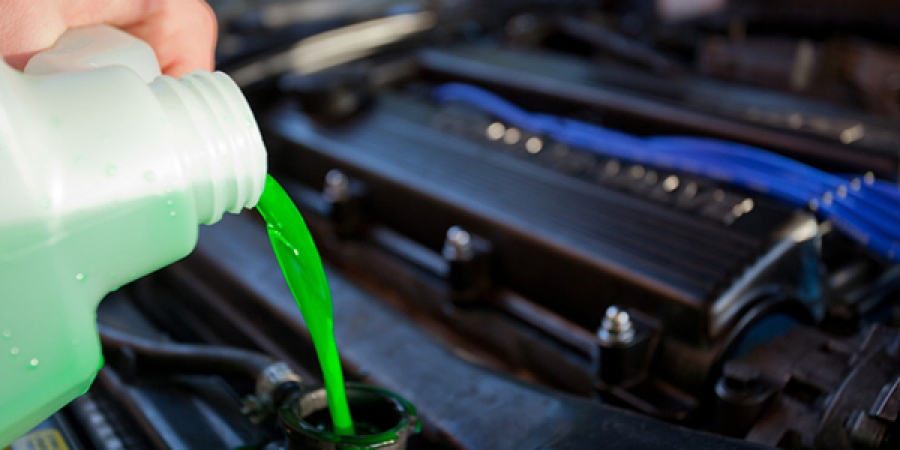
In the first part of the material about automobile antifreezes, we figured out what coolants are for and what they are. In the second part we will talk in detail about which “coolant” to choose for a particular model and how to correctly change the antifreeze with your own hands.
How to choose coolant for a car?
When purchasing coolant for a car, we recommend following the manufacturer’s recommendations.
The instruction manual clearly states which antifreeze can be used in the engine cooling system of a particular vehicle.
If for some reason you cannot find the fluid that was poured into your car from the factory, buy a coolant that is close in characteristics to stock. You can find out which antifreeze is suitable for your car from official dealers.
Original BMW antifreeze. Almost every manufacturer offers antifreeze under its own brand. It is not necessary to use it, the main thing is that the purchased liquid complies with the specifications in the instructions.
How much antifreeze should I pour into the engine cooling system?
The amount of coolant for a particular car model is indicated in the owner's manual. On average, you will need 6-8 liters of coolant.
How to replace coolant with your own hands?
There is nothing complicated about replacing the factory-filled coolant, so you can carry out this operation yourself. We recommend that you wear gloves before changing the coolant - coolants are very toxic; if they come into contact with exposed skin, they can be absorbed through the skin and cause severe poisoning.
The algorithm for replacing antifreeze in a car looks like this:
- We install the car on a lift (inspection hole);
- Open the hood, unscrew the cap of the expansion tank, radiator, engine cylinder block, unscrew the thermostat housing (up to 1 liter of coolant may remain here);
Expansion tank cap
- Open the radiator tap of the heating system;
- Drain the old coolant into a container prepared in advance (volume up to 10 liters)
Draining the antifreeze
- We rinse the system with distilled water (the required amount is from 10 liters). At the same time, we turn on the engine, which should run from 30 minutes to an hour - depending on how dirty the “cooling” system was;
Attention : if the antifreeze in the system has not been changed for a long time, and you find impurities in the drained liquid, then the system line is probably contaminated with rust and deposits that gave additives.
In this case, the system is washed with special detergents based on organic acids (oxalic or formic).
After flushing the engine cooling system with such means, rinse its line with distilled water.
- We tighten the plugs of the radiators, the cylinder block, and screw the thermostat housing;
- Pour new coolant into the neck of the expansion tank and replace the tank cap;
- We start the engine and let it run for 15-20 minutes. Then we check the coolant level using the marks on the expansion tank. If necessary, add antifreeze to the required level (the liquid should be between the Min and Max marks).
Pour antifreeze into the expansion tank
Source: https://avtoexperts.ru/article/kak-zamenit-antifriz-podrobnaya-instruktsiya/
Replacing the coolant, how to mix antifreeze, how to drain antifreeze correctly, is it possible to check the level without removing the drain plug
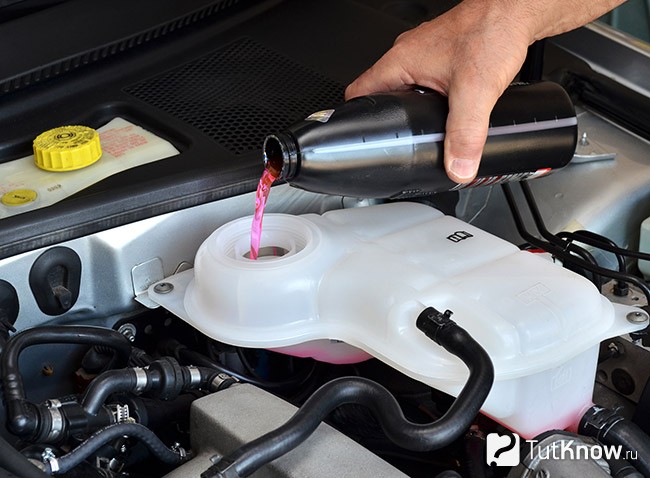
In an internal combustion engine, not only the main internal parts wear out, but also the fluids that provide lubrication and cooling of the unit.
Replacing antifreeze is necessary to remove deposits, as well as to restore the density of the coolant if water was added to the cooling system during vehicle operation.
You can replace the coolant yourself, but only if you follow the basic rules and requirements for performing this type of machine maintenance work. How to replace antifreeze or antifreeze will be discussed in this article.
Procedure for replacing coolant
Antifreeze is replaced in the following sequence:
- The old coolant is drained;
- The cooling system is flushed;
- New antifreeze is added.
Drain antifreeze or antifreeze
In order to figure out how to drain antifreeze, you do not need to study textbooks on the design of internal combustion engines. Draining the antifreeze is done very simply, in the following sequence:
- The engine of each car has a special drain plug or faucet through which the coolant is removed. If the cylinder block is at an angle with respect to the vertical plane, then the coolant drain point will be on the side towards which the inclination is directed;
- In addition to the cylinder block, antifreeze is drained from the radiator and expansion tank. The design of the radiator also provides a drain hole, which is made in the form of a plug. To remove fluid from the expansion tank in some car models, you will need to remove the hose from the lower pipe.
After draining the coolant, be sure to dispose of it according to the rules for handling hazardous substances. We figured out how to drain the antifreeze, but you can’t fill in new coolant immediately after performing this procedure. First, it is necessary to remove deposits that form on the walls of the cooling system by flushing the system.
Flushing the cooling system
Coolant replacement must be carried out with mandatory flushing of the entire system. This must be done to remove deposits in the radiator and engine channels. You can flush the system with the following liquids:
- Distilled water;
- By special means.
Flushing the cooling system with distilled water is the least effective, but if the liquid is acidified, scale will be separated from metal parts much better.
You should not lower the pH level too much. In order not to damage the rubber parts of the cooling system, it is enough to use one packet of citric acid or half a small bottle of vinegar essence for the entire volume of liquid poured into the engine.
After the acid is thoroughly dissolved, water is poured into the engine cooling system. In this case, it is necessary to control the fluid level, which will constantly decrease as air is displaced from the engine and radiator channels.
When the coolant level is fixed and does not decrease, you need to start the engine for 15 - 20 minutes. During this time, the water temperature will increase to the operating value.
After warming up, the engine should be turned off and the acidified water should be kept in the system for 5 - 6 hours.
After this time, the water from the cooling system is drained and the cleaning cycle is completely repeated using clean distilled water.
When flushing with clean water, the required amount of liquid is also poured, then the engine is started for 15 - 20 minutes, after which the engine is allowed to cool for half an hour, and then the water is drained from the system.
Flushing with the help of special products allows you not only to carry out high-quality cleaning of the cooling system, but also save a considerable amount of time. The greatest efficiency when replacing antifreeze can be achieved if the flushing actions are carried out using a two-component product.
Professional flushing fluids allow you to completely clean the cooling system of antifreeze decay products, as well as scale and corrosion products of metal engine parts. The cleaning process using special products is not too different from rinsing with distilled water.
Time is saved due to the fact that such fluids contain highly effective additives, which make it possible to separate various foreign formations from metal parts of the cooling system within a short time.
That is, it is not necessary to keep such liquids in the system for a long time.
Filling with new antifreeze
Before pouring new antifreeze, you need to make sure that all previously unscrewed plugs and open taps are completely closed and installed in their place.
To control the process of filling the engine cooling system with new antifreeze, it is necessary to remove the upper hose from the expansion tank and place it at the level of the bottom plane of the tank. Then antifreeze is poured in a volume of 8 - 10 liters. Coolant is poured in until the antifreeze level rises to the bottom plane of the expansion tank.
This moment can be determined by the start of antifreeze flowing out of the hose.
After filling the antifreeze, you need to start the car engine for 10 - 15 minutes to heat the coolant to operating temperature. If the antifreeze level changes, then fill the expansion tank with antifreeze to the maximum level.
Tips and tricks
- If the coolant evaporates, the volume should be restored with distilled water. If coolant pours out of the engine, from cracks in the radiator or damaged pipes, then antifreeze is added.
With this method of volume restoration, mixing different types of antifreeze is strictly prohibited;
- If you need to prepare coolant from concentrate, then mix antifreeze with distilled water in a 1 to 1 ratio.
At this concentration, you will get antifreeze with a freezing point of about minus 35 degrees;
- If you don’t want to change the antifreeze yourself, you can carry out this operation at any car service station.
However, in this case you will have to pay not only the cost of the coolant, but also the work of the craftsmen;
- Many motorists are interested in: “Can I use tap water instead of antifreeze?” Using undistilled water as a coolant will lead to excessive scale formation, and in the winter, the water in the cooling system will freeze and rupture the elements of the engine cooling system.
How to fill antifreeze correctly is described in detail in this article, and armed with theoretical knowledge, you can safely begin replacing the antifreeze yourself. After gaining the first experience, the next coolant change will be done much faster, and there will be no need to waste time searching and studying educational materials on this topic.
Source: https://SwapMotor.ru/tehnicheskoe-obsluzhivanie/zamena-ohlazhdayushhej-zhidkosti.html
How to check and replace coolant?
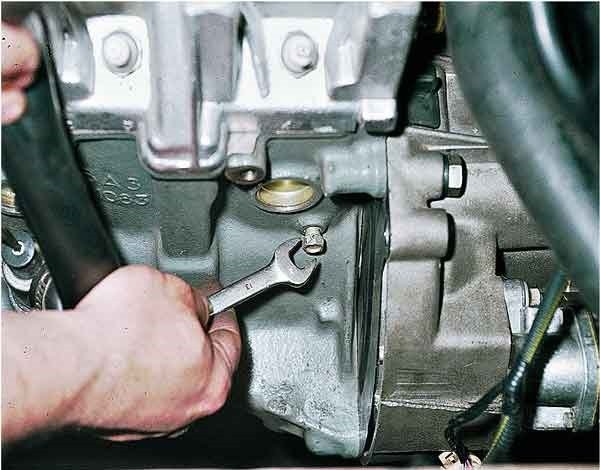
The cooling system in your backhoe requires regular attention. An important part of periodic maintenance is checking the coolant level. It should be tested every day.
The quality of the antifreeze composition must be checked every year, before frosts. Replacement is carried out every couple of years.
Procedure for replacing coolant
ATTENTION! The system can only be operated with a cooled engine. If the engine is hot, fluid may spray out under pressure when the cap is opened. It is very dangerous.
- Gain access to the motor.
- Loosen the antifreeze tank cap and relieve pressure before proceeding further.
- Place the container of the required parameters under the radiator.
- Pull out the hose attached to the radiator from below.
- Flush the system with clean water. Then attach the cable back to the radiator.
- Fill the antifreeze tank with a mixture of clean water and coolant. Add solution to the minimum mark. To prevent air from entering the cooling system, pour liquid gradually, maintaining the highest filling rate.
- Start the engine. The temperature will increase and the antifreeze pressure will increase to the operating parameter. Check the cabin heater, it should be directed to heat. This position improves the movement of the cooling mixture through the system.
- Turn off the engine and check the system for leaks. Test the antifreeze level and add as much fluid as required.
Procedure for checking coolant
ATTENTION! Be careful when working on the cooling system. Before checking or replacing, make sure the motor is not hot. Otherwise, heated coolant under pressure may splash out on you and cause serious burns.
- Access the motor by removing the motor cover.
- Check that the antifreeze level on the corresponding tank is between the MIN and MAX parameters.
- Loosen the coolant tank cap. Make sure the pressure is released before removing it. Fill the mixture inside with water and antifreeze to the required level. To prevent air from entering the cooling system, pour liquid gradually, maintaining the highest filling rate.
- Start the engine. The temperature will increase and the antifreeze pressure will increase to the operating parameter. Then turn off the engine and check the system for leaks.
Source: http://jcbpro.ru/pages/stati/kak-proverit-i-zamenit-ohlazhdayushchuyu-zhidkost.html
Self-replacement of coolant (antifreeze or antifreeze)
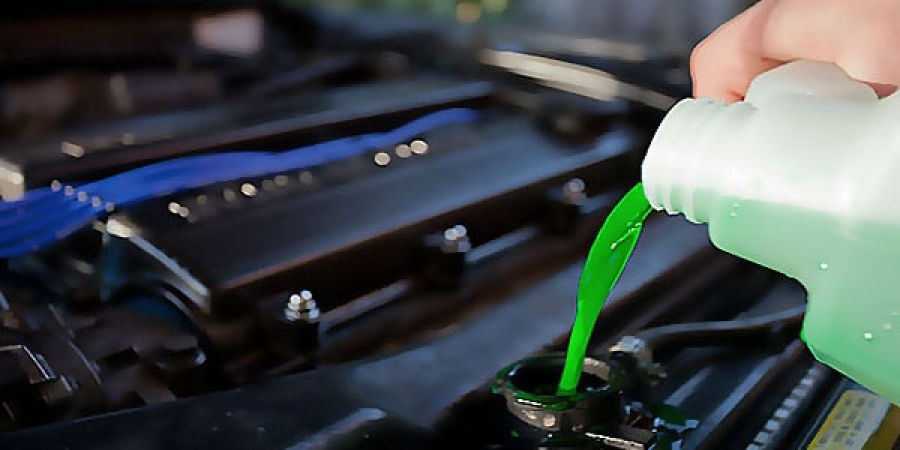
Timely replacement of coolant is a procedure that many car owners neglect. And in vain. Engine performance directly depends on the cooling system. In this article we will tell you how to change antifreeze correctly with your own hands, because to change the coolant it is not at all necessary to go to a car service center.
The easiest way to replace the coolant will be if you have a garage and an inspection hole, although these are not necessary conditions. The procedure for replacing antifreeze on all cars is approximately the same:
- The old coolant must be completely drained.
- Flush the engine cooling system.
- Fill with new coolant (antifreeze or antifreeze).
At the end of the article, as always, watch the video instructions on how to replace the coolant with your own hands on a VAZ 2110 car. In the meantime, we will look at all the stages of replacing antifreeze one by one.
How to drain coolant
In order to completely drain the coolant from the system without any residue, it is desirable that the front of the machine is lower relative to the rear. For example, the rear can be jacked up a little.
Now let's start draining the old antifreeze before replacing it with a new one. Most car engines have a tap or a special drain plug in their lower part through which the coolant is drained. In addition to the cylinder block, antifreeze will also need to be drained from the radiator and expansion tank.
To do this you need:
- Loosen the expansion tank cap - this will allow the coolant to drain faster.
- Unscrew the drain plug and drain the antifreeze from the engine cooling jacket into a suitable container placed under the drain hole.
- Unscrew the drain valve or lower radiator cap and drain the old coolant from it in the same way.
The pressure of the drained liquid can be adjusted by unscrewing or tightening the cap of the expansion tank. After draining the coolant, be sure to screw all drain plugs back in.
Flushing the engine cooling system
We have already written in some detail about flushing the engine cooling system.
First of all, flushing has two purposes:
- Cleans the system of dirt and sediment that may interfere with heat transfer and coolant circulation.
- Removing the remnants of the previous antifreeze. This operation is necessary because when mixing different coolants, their components may enter into an undesirable reaction, and thereby weaken the anti-corrosion properties of fresh antifreeze.
Even 20-30 years ago, car enthusiasts used various folk methods to clean the cooling system of contaminants. For example, vinegar essence or citric acid was poured into the radiator. Today, there are many special formulations that cope with this task much more effectively.
Special flushing concentrates are best suited for flushing the system when replacing coolant. Before use, they are diluted with water in the proportion indicated on the package. This is the so-called “soft rinsing”.
Its advantage over compounds poured into old antifreeze is that it acts as a preliminary primer. That is, a certain amount of additives from the solution settles on the metal even at the washing stage, and when you fill in fresh coolant during replacement, it will work much more efficiently in the already prepared environment and will not oxidize.
This completes the independent coolant replacement.
Filling with new coolant
Now we can start filling in new coolant. Remember, pouring new antifreeze when replacing is only possible in a clean cooling system.
However, before doing this, it is important to understand what exactly you are going to fill. After all, there is no such confusing classification as that of coolants anywhere else. Therefore, we strongly recommend that you first study what types and types of antifreeze there are, and then you will understand what is best to pour into the engine cooling system.
If you use antifreeze concentrate when replacing, it must first be diluted with distilled water in a one-to-one ratio before filling. With this ratio, it can withstand frost down to -40 °C. All proportions and diagrams are usually indicated directly on the coolant package.
To avoid the formation of air jams in the system, the car must be in a strictly horizontal position. Then follow in this order:
- Disconnect the uppermost pipe that supplies antifreeze to the engine (usually located in the intake manifold area). See the video below for an example.
- New coolant should be poured through the neck of the expansion tank. For convenience, it is better to use a funnel.
- Fill in antifreeze until it begins to flow out of the pipe disconnected at the first point.
- Insert the pipe into place and clamp it at the connection with a clamp.
- Do not fill the tank full of antifreeze. The optimal level will be between the MIN and MAX marks.
After filling, close the reservoir cap tightly, start the car and warm it up until the fan comes on. Then wait until the engine cools down and check the coolant level in the expansion tank. If necessary, antifreeze should be added to the required level, but this can only be done with a cold engine!
This completes the independent coolant replacement.
Video instructions for replacing coolant on a VAZ 2110 car
Source: https://unit-car.com/tehnicheskoe-obsluzhivanie/189-zamena-antifreeza.html
How to properly replace coolant (antifreeze)?
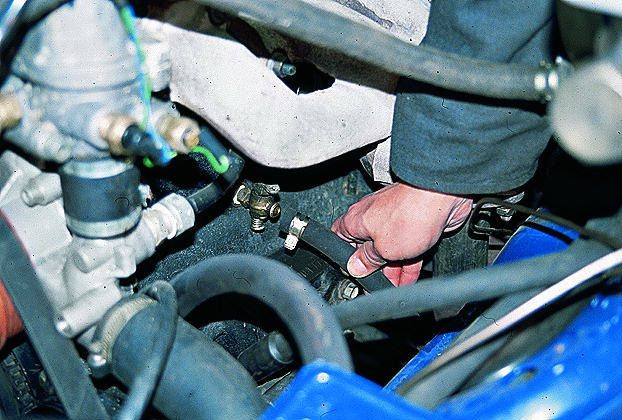
18.01.2013
From time to time, every driver will have to deal with this operation. It is worth noting that the coolant must be replaced on time, otherwise engine problems cannot be avoided.
Do I need to change antifreeze (antifreeze)? How to properly replace coolant. Answer: definitely necessary! The fact is that over time, the coolant loses its cooling properties, heats up quickly, and the engine wears out.
How often do you change antifreeze or antifreeze?
To determine when to change antifreeze or antifreeze, you need to consider the following factors:
- Shelf life of antifreeze.
- Manufacturer's recommended coolant mileage when replacing.
- Current state of the liquid: color.
Each coolant has its own expiration date:
- Antifreeze – 2 years.
- Antifreeze - 5 years.
You also need to pay attention to what mileage your coolant is designed for: the bottles always indicate the lifespan of the coolant: it could be 20 thousand, maybe 40 thousand.
The color says a lot: if you initially poured blue antifreeze, and after some time it turned green, brown, then this means the demise of the additives - the coolant needs to be replaced.
Is it possible to mix antifreeze with antifreeze?
Many people write that it is absolutely forbidden to mix antifreeze with antifreeze. In part this is true, but in part it is not. The fact is that this established stereotype is the result of a marketing ploy. You can mix, but not everything.
Antifreeze and antifreeze are based on the same ethylene glycols and other additives. Also, don’t forget the dye.
It’s just that if we mix red and blue, we’ll get a dirty brown color, and we won’t see any leaks on the pipe if they appear.
There is a special additional antifreeze labeled G12+. This antifreeze is used as an additional antifreeze, i.e. You can add it to both antifreeze and antifreeze.
G11 G12, (i.e. cannot be mixed) G12+ can be added to G11 G12+ can be added to G12
G12+ can be added to G12+
1.5 liters of such additional antifreeze cost about 220 rubles. It can be diluted with water to obtain:
- 3 liters of ready-made antifreeze with a freezing point of up to -37;
- 4 liters of antifreeze with a freezing point of -25;
- 5 liters of antifreeze with a freezing point of -15.
It can be diluted with either distilled water or boiled or melted water.
Thus, we answered the following question: Is it possible to dilute antifreeze and antifreeze with water? You can, but keep in mind that by diluting the coolant with water, you lower the boiling point and reduce the freezing point.
What is better antifreeze or antifreeze?
Naturally antifreeze, no question here. Antifreeze has a lower boiling point, a shorter shelf life, and pollutes and wears out the cooling system. Accordingly, the price of antifreeze is lower than that of antifreeze.
How to properly replace antifreeze with antifreeze?
We have already verified the advantage of antifreeze over antifreeze, now let’s look at the question of how to replace antifreeze with antifreeze? In principle, the procedure is the same as when replacing the coolant, only you need to clean the system more thoroughly (read further).
How to replace antifreeze (antifreeze)?
To replace, we will need a basin, keys for “8”, “13”, “17”, distilled water, new antifreeze with a volume of 8-10 liters.
Next we need to do the following:
- Drain the old coolant.
- Flush the cooling system.
- Fill with new fluid.
How to drain the coolant?
In order to drain the old coolant, follow the following link: (How to drain the coolant (antifreeze, antifreeze)?)
How to flush the cooling system?
If the car is very old and the cooling system has never been flushed, then there is a risk that if you flush it now, you will clog the radiator, heater core, or thermostat. Also, the use of various types of coolant additives is not recommended, because There is also a risk of clogging the same elements of the cooling system.
- After draining the old coolant, screw all the plugs back into place and fill the tank with distilled water up to the max mark.
- Start the engine and warm it up to operating temperature.
- Let it run for 10 minutes at 2500-3000 rpm. But do not forget to monitor the engine temperature, do not overheat it.
- turn off the engine and let it sit for 6-7 minutes. Then we drain again as we did earlier. We look at the condition of the water: if it is dirty, then we repeat this operation several times until the distilled water is clean.
How to add antifreeze?
- Tighten the drain plugs well.
- Unscrew the hose on the throttle assembly as shown in the figure.
- Start adding new coolant.
- Fill until it flows out of the hose.
- Reinstall the hose and secure it well with the clamp.
- Add liquid to the barrel up to the max mark.
- Close the expansion tank with a lid and start the engine and heater.
- Warm it up to operating temperature and turn it off.
- If necessary, add liquid to the barrel.
If cold air blows from the heater at operating temperature, it means there is air left in the cooling system.
To expel it, read the article: How to remove an air lock?
Source: http://vaz-2114-lada.ru/2013/01/kak-pravilno-zamenit-okhlazhdayushhuyu-zhidkost-tosol-antifriz/
Replacing antifreeze - is it necessary?
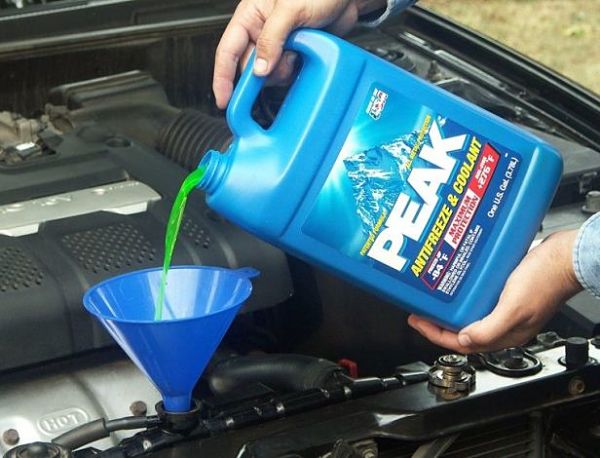
Antifreeze is a general name for all types of liquids that do not freeze at very low temperatures. The vast majority of them are used in various installations that operate at very low temperatures.
The main purpose of such substances is to cool internal combustion engines.
Thus, the basic structural elements of antifreeze liquids can be mixtures of propylene glycol, ethylene glycol, monohydric alcohols, glycerin and other substances that contain water.
Thus, coolant for a vehicle includes water, antifreeze, and special additives that are responsible for corrosion processes in the cooling system of an internal combustion engine.
In addition, the coolant contains: a liquid that protects the unit from thermochemical destruction, and lubricants that are intended for the cooling system pump. In this case, antifreeze is a compound that, when directly mixed with water, the freezing point of the substance is significantly reduced.
So, antifreezes are all aqueous solutions that consist of inorganic salts, aniline, alcohols, glycerin, glycols and many other substances.
If you look at it, vehicle coolants play a very important role.
This is due to the fact that it is this particular structural element that makes it possible to maintain the normalized temperature of the internal combustion engine during periods of direct operation.
It is necessary to constantly monitor the level of the car’s coolant, since it is precisely because of its absence that breakdowns can occur when the car is moving, on the road, which may require quite expensive car repairs.
https://www.youtube.com/watch?v=uGqoCd-YjA8
The amount of coolant that needs to be poured into a car depends entirely on the make and model of the car. Thus, domestic cars in most cases use antifreeze, while imported cars use antifreeze.
Naturally, antifreeze is the best liquid, as it has many advantages in comparison with its counterpart.
Antifreeze helps increase the efficiency of the engine cooling system, as it can provide excellent protection for aluminum if temperatures are high enough.
In addition, antifreeze has a significantly longer service life, thereby increasing the service life of the water pump.
This liquid also protects engine cylinder liners from cavitation and prevents various types of clogging in the car radiator.
With increased compatibility with elastomers and plates, it is the most stable “device” when operating at high temperatures.
Antifreeze can be purchased either as a ready-made single element or as a concentrate, which must be diluted with distilled water in a certain ratio indicated on the package. After purchasing and purchasing antifreeze, you can begin to directly replace it. To do this, you will need to use a 30mm open-end wrench, as well as a 13mm spanner, a container for draining the liquid and a screwdriver.
1. Antifreeze for cars - properties and purpose
The demands placed on coolant are very high. Thus, the main criteria are: high thermal conductivity, chemical stability; at sub-zero temperatures, ice crystals should not form in it; at the operating temperature of the internal engine, they should not boil, excluding the destruction of contacting materials.
The most common are antifreezes, which have a boiling point of +130 degrees and a freezing point of -38 . With all this, this is a 50% aqueous solution of antifreeze, which is often sold in the form of a concentrate, as a result of which it must be diluted before direct refueling into the vehicle.
To avoid counterfeiting in antifreeze, certain state standards were invented. Thus, all antifreezes that have received international certification must meet all minimum requirements.
All those fluids that are certified by an international organization cannot last forever, since the anti-corrosion properties are reduced to their minimum in this case, as a result of which this has a negative impact on the operation of the internal combustion engine of the car.
To avoid these types of problems, you should replace your coolant every few years, although it is best to do this preventative maintenance every year.
2. Replacing antifreeze: frequency
The main sign that your car's coolant needs to be replaced is a change in the color of the fluid. In addition, you need to sound the alarm in those periods when a certain sediment begins to appear in it. How often to replace antifreeze depends directly on the make and model of the vehicle.
Thus, there is a huge variety of different antifreezes, which arises through original manufacturers who add various patented additives that protect the internal combustion engine from corrosion.
This kind of liquid must be poured into the car in accordance with the instructions and the passport, since it is there that the desired composition and concentration of the required mixture are indicated.
In addition, you can contact a service center, where your own vehicle is often serviced.
In order to replace with new antifreeze, you need to completely clear the container of the old one and flush the entire cooling system of the car.
Otherwise, various chemical reactions may occur between the new and old liquid, which, in turn, will lead to quite disastrous consequences.
To a greater extent, this is relevant for those who previously used antifreeze, and now intend to introduce imported antifreeze into the cooling system. These elements have different basic protective principles for protecting metal from corrosion.
So, if you rinse all the tubes poorly, then this kind of defect will come out after a short period of time. Filling and draining antifreeze is necessary only when the engine is cold, when the car has not been used for 4-5 hours before. If the engine is hot, there is a possibility of getting burns or poisoning.
3. How to choose antifreeze for a car - what should you look for on the label?
When the time for replacing the coolant has arrived, the motorist goes to the store and tries to choose the right coolant for his car.
Previously, when we didn’t have such a large number of foreign cars, car enthusiasts knew only antifreeze, therefore the choice between this kind of coolant is rather small.
So, there were 2 types of such antifreeze, which differed in freezing temperature: - 40 degrees and - 65 degrees, depending on the region where the car lives.
For the compositions of imported antifreeze, colors also play a role, which determine different freezing thresholds. So, there are red, blue, green and yellow antifreezes , which have different temperature indicators. It is the color that indicates the maximum temperature range in which the liquid fluctuates in its normal state and position.
In most cases, in addition, the color indicates the difference in the lower threshold. Modern manufacturers make this kind of innovation in order to define and identify their own brand, which symbolizes high quality and durability.
Red antifreeze often highlights the branded products of giant companies such as Audi and General Motors. It would be incorrect to establish a “color-freezing temperature” relationship, since the same color does not always correspond to a certain temperature.
It is important to know that under no circumstances should you mix liquids of different colors and from different manufacturers, since the chemical components of these substances may differ.
Directly on the antifreeze instructions near the inscription “CODEG” there are numbers that are responsible for the years of use in vehicles.
So, if the car was produced before 1996, then the number will be 11, if the car is from 1996 to 2001, then the number should be 12, and for all vehicles that appeared after 2001 - 12 plus. In addition, you can determine antifreeze by compatibility with colors.
So, if it is yellow, it is universal for all cars. If red or other, then mixing is unacceptable.
Source: https://auto.today/bok/3007-zamena-antifriza-nuzhno-li-delat.html


